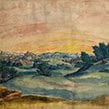Margravial Graphic Collection
 The Graphic Collection of the Friedrich Alexander University Erlangen-Nürnberg is considered the only testimony of Nuremberg′s tradition of art collecting to have survived undamaged. Objects such as specimen leaves, sketches, compositional drafts, safety copies, or independent coloured works were kept in the city′s artists′ workshops of the 14th and 15th centuries for operational purposes. They soon enjoyed the interest of art minded merchants.
The Graphic Collection of the Friedrich Alexander University Erlangen-Nürnberg is considered the only testimony of Nuremberg′s tradition of art collecting to have survived undamaged. Objects such as specimen leaves, sketches, compositional drafts, safety copies, or independent coloured works were kept in the city′s artists′ workshops of the 14th and 15th centuries for operational purposes. They soon enjoyed the interest of art minded merchants.
Presumably during the 17th century, the prints and drawings were added to the rich collection of art of the margraves of Brandenburg-Ansbach. After the margraviate of Ansbach-Bayreuth was incorporated into the Prussian state in the late 18th century, the graphic collection as well as the books from the palace library were transferred to the University Library (1805/06), which has been home to them ever since.
The graphic collection consists of 1,987 drawings, 4,000 copperplate engravings and etchings, and 1,000 woodcuts dating from the 14th to the early 18th century. Apart from several drawings and numerous prints by Albrecht Dürer, there are leaves by all renowned artists of the time.
Although the collection in Erlangen may not be one of the largest, in terms of artistic value it is doubtlessly comparable to the world′s great graphic collections. Along with Paris, Vienna, Berlin, and New York, it is one of the most important for 15th and 16th century art from northern Europe.